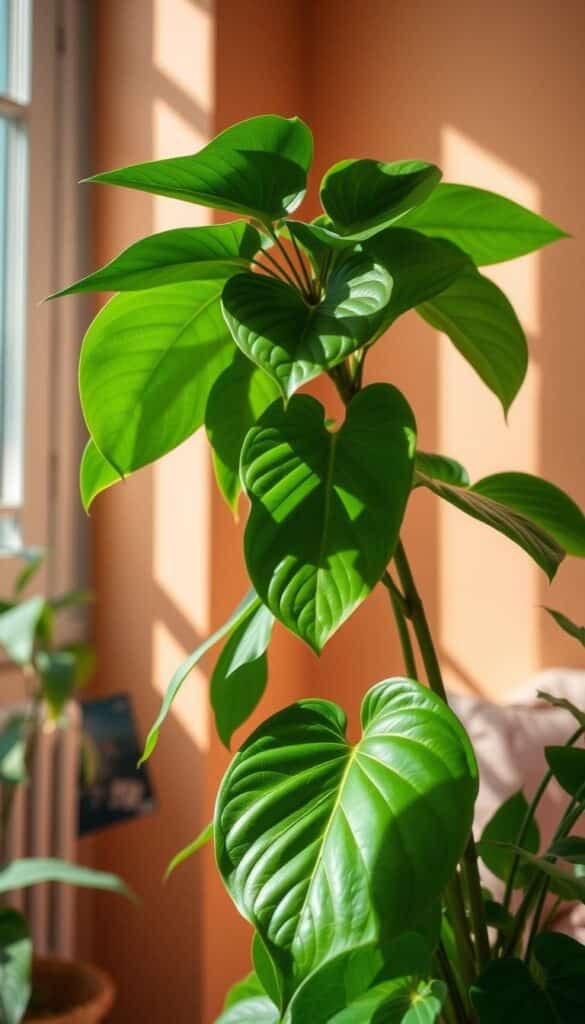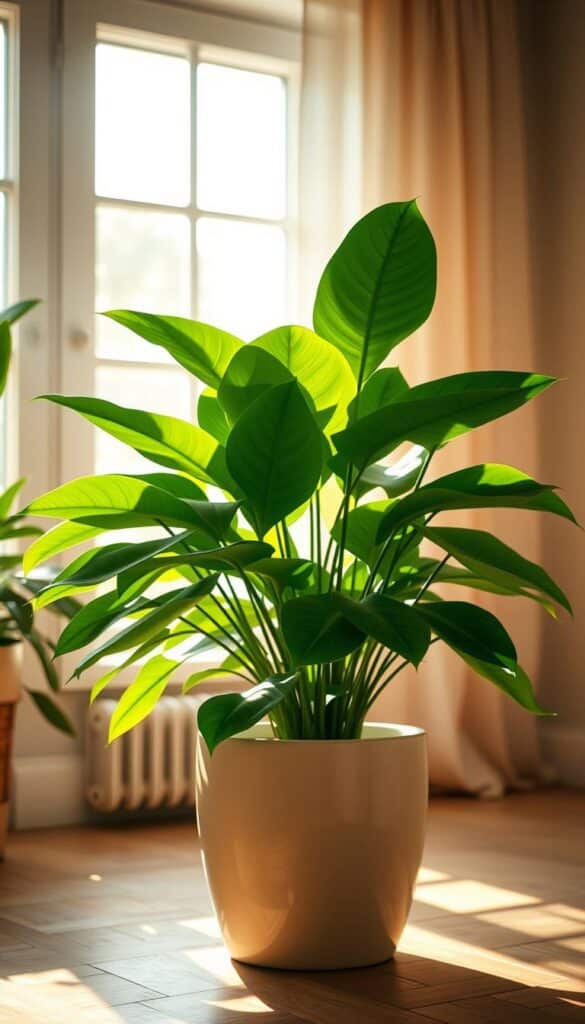Meet the Philodendron Imperial Green, a stunning houseplant that has captured the hearts of many indoor gardeners, including mine. With its glossy, upright leaves and elegant growth habit, this plant is not just a decorative piece but also a natural air purifier, making it a fantastic addition to any home or office.
As someone who has nurtured this beautiful plant, I can attest to its easy-going nature. It’s perfect for both beginners and seasoned plant enthusiasts. In this guide, I’ll share expert tips on lighting, watering, and everything else you need to keep your Philodendron Imperial Green thriving.
One of the most common challenges I’ve faced with this plant is over-watering. It’s crucial to find that perfect balance to ensure your plant stays healthy and vibrant. Through trial and error, I’ve learned the best practices to maintain its beauty and promote healthy growth.
In the following sections, I’ll dive into detailed care routines, troubleshooting common issues, and even repotting. Every tip is backed by reliable information and my own hands-on experience, so you can trust you’re getting the best advice for your Philodendron Imperial Green.
Essential Indoor Care for Your Philodendron Imperial Green
Creating the right indoor environment is key to keeping your plant happy and healthy. By focusing on a few simple care practices, you can ensure your plant thrives all year round.
Optimal Lighting and Temperature
Lighting plays a crucial role in the health of your plant. Place it in a spot with bright, indirect light—direct sunlight can scorch the leaves. The ideal temperature range is between 65-85°F. Sudden temperature swings can stress the plant, so keep it away from drafty windows and doors.
Watering Techniques and Soil Benefits
Watering is where many plant parents go wrong. Water only when the top inches of soil feel dry to the touch. Use well-draining soil to prevent root rot, a common issue if the soil stays too moist. A proper pot with good drainage holes is essential to keep your plant healthy and thriving.
| Factor | Recommendation | Benefits |
|---|---|---|
| Lighting | Bright, indirect light | Prevents leaf scorch |
| Temperature | 65-85°F | Supports healthy growth |
| Watering | Water when top soil is dry | Prevents root rot |
| Soil | Well-draining mix | Ensures healthy roots |
| Pot | Use a pot with drainage holes | Reduces waterlogging risk |
Your philodendron imperial green care guide
Keeping your Philodendron Imperial Green thriving involves a few simple yet essential steps. By following these daily routines and planting tips, you’ll enjoy a lush, vibrant plant all year round.
Step-by-Step Planting and Daily Maintenance
Let me walk you through how I keep my Philodendron Imperial Green in top shape.
- Start by selecting a pot that offers enough space for growth. I choose pots with drainage holes to prevent waterlogging.
- Plant the Philodendron in well-draining soil to ensure healthy root development.
- Water only when the top inches of soil feel dry. Overwatering can lead to root rot, so it’s crucial to check the soil moisture regularly.
- Feed your plant with a balanced fertilizer during the growing season. I dilute the fertilizer to half the recommended strength to avoid burning the roots.
- Monitor your plant’s growth and size throughout the year. Prune any yellow leaves to maintain its vigor and appearance.
| Factor | Recommendation | Benefits |
|---|---|---|
| Lighting | Bright, indirect light | Prevents leaf scorch |
| Watering | Water when top soil is dry | Prevents root rot |
| Fertilizing | Dilute fertilizer by half | Promotes healthy growth |
| Monitoring | Check for yellow leaves | Maintains plant vigor |

By following these steps, you’ll create an ideal environment for your Philodendron Imperial Green to flourish. Regular maintenance and careful watering will ensure it remains a stunning addition to your space.
Troubleshooting Common Issues and Preventing Root Rot
Every plant parent runs into issues now and then. With my Philodendron Imperial Green, I’ve learned that catching problems early makes all the difference. Let’s dive into some common challenges and how to tackle them.
Recognizing Signs of Overwatering and Yellow Leaves
One of the first signs of trouble is yellow or drooping leaves. If you notice this, it’s likely your plant is getting too much water. I check the soil by sticking my finger in about an inch deep. If it’s wet, I wait another day before watering again. This “dry watering” technique helps prevent root rot.
Another sign is soft, mushy stems. If this happens, stop watering immediately and repot the plant with fresh, well-draining soil. It’s also a good idea to trim any affected roots to save the rest of the plant.
Managing Pests and Leaf Damage
Pests can sneak up on you, especially spider mites and mealybugs. I inspect my plant regularly, looking for tiny white spots or sticky residue. If I find any, I treat the plant with insecticidal soap, making sure to spray the undersides of the leaves where pests like to hide.
For minor leaf damage, I just trim off the affected leaves with clean scissors. This keeps the plant looking healthy and prevents the damage from spreading.
Adjusting Light and Humidity Levels
Sometimes, even with good care, your plant might need a little adjustment. If the leaves are losing their vibrancy, it might need more humidity. I place the pot on a tray filled with water and pebbles to create a humid microclimate without risking root rot.
If the plant is stretching or not growing as expected, it’s probably not getting enough light. Moving it to a brighter spot, but still out of direct sunlight, usually does the trick.
By staying vigilant and making small adjustments, you can keep your Philodendron Imperial Green happy and thriving. Remember, it’s all about balance and quick action when you spot a problem!
Enhancing Growth with Proper Fertilizing and Repotting
Nurturing your plant to reach its full potential involves more than just the basics. I’ve found that the right fertilizer and timely repotting can make a world of difference in promoting healthy growth and vibrant leaves.
Choosing the Right Fertilizer and Dilution
During the growing season, which typically runs from spring to fall, I use a balanced, water-soluble fertilizer. My go-to is a 20-20-20 formula because it provides equal amounts of nitrogen, phosphorus, and potassium. These nutrients support leaf growth, root development, and overall plant health.
I dilute the fertilizer to half the recommended strength to prevent burning the roots. Over-fertilizing is a common mistake that can harm your plant, so it’s better to err on the side of caution. I apply the fertilizer every 2-3 weeks, making sure the soil is moist but not waterlogged before feeding.
It’s also important to skip fertilizing during the winter months when the plant is dormant. This gives the roots a chance to rest and recharge for the next growing season.
Effective Repotting Techniques for Vigorous Growth
Repotting is essential for giving your plant room to grow. I recommend repotting every year or when the plant has doubled in size. Choose a pot that’s only slightly larger than the current one to prevent the soil from becoming too wet.
When repotting, gently remove the plant from its pot and inspect the roots. If the roots are circling or growing out of the drainage holes, it’s definitely time to move to a bigger pot. I also check for any signs of root rot and trim affected areas with clean scissors to prevent the spread of disease.
After repotting, water the plant thoroughly to settle the soil. Keep the plant in bright, indirect sunlight and maintain consistent temperatures between 65-85°F for optimal recovery and growth.

By following these fertilizing and repotting tips, you’ll be well on your way to helping your plant thrive. Remember, it’s all about creating a balanced and nurturing environment that meets your plant’s specific needs.
Wrapping Up with Insider Tips for a Thriving Plant
As I reflect on my journey with this beautiful plant, I want to share my most valuable insider tips to help you keep your plant thriving. Regular inspection is key—check your plant often for any family-like signs of distress, like yellow leaves or droopy stems. These can signal issues before they become serious.
Pay attention to every small spot of damage on the leaves or stems. Addressing these early can prevent bigger problems down the line. Always keep your plant’s well-being in mind when making adjustments to its environment or routine.
Consistency has been my secret weapon in plant care. By sticking to a regular watering and fertilizing schedule, my plant has grown strong and vibrant. It’s amazing how such simple routines can make such a big difference.
I’d love to hear about your experiences! Share your tips and stories with our growing community of plant enthusiasts. Together, we can learn and grow, ensuring our plants continue to bring beauty and joy to our spaces.
